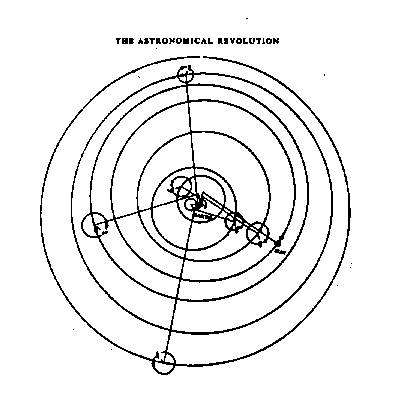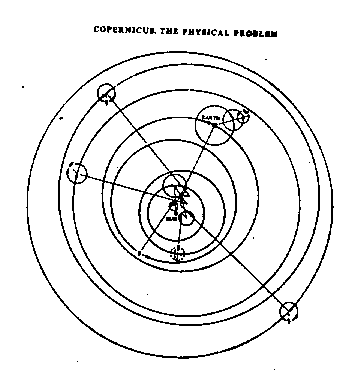
(from The Astronomical Revolution by Alexandre Koyre)
As long ago as the third century B.C., a Greek astronomer, Aristarchus of Samos, proposed that the Earth is a planet that circles the Sun, like Mercury and Venus. When the Earth passes between the Sun and an outer planet, which is moving more slowly than the Earth, It appears that the outer planet is moving backwards (a phenomena which is currently called "retrograde motion"). This theory fit well with observations of the planets that astronomers had made. However, the idea that the Earth was moving did not seem to make sense.
In the second century A.D., Claudius Ptolemy of Alexandria proposed that the Earth must be at rest, in the centre, and the Sun, Moon, and other planets must all be circling around the Earth. However, the Earth is not always at the centre of their circular paths: the circular paths were generally drawn off-centre, and this was to account for observations that astronomers had made. Already, astronomers had recorded a lot of observations about the location of each planet at different times. Ptolemy realized that even these off-centre circles were not enough to match the observations, so he added small circles to the orbits of the planets, called "epicycles". As Mars, for example, moves in its circle around the Earth, it also moves in a small circle around a point on it's large circular orbit. Thus all the observations were accounted for, and what's more, the Earth was placed at the centre of the system.
Diagram 1: Ptolemaic System

Ptolemy's system dominated Astronomy until about the sixteenth century A.D., when Nicolaus Copernicus revived Aristarchus's idea of the Earth circling the Sun, just like all the other planets. In Copernicus's system, the Moon circles around the Earth, and the Earth and other planets circle around the Sun in their own off-centre orbits, with their own epicycles. Copernicus's system was no better at explaining the observations than Ptolemy's system. The difference is that it introduced another way of looking at the system: a system in which the Earth moves, and the Sun is at the centre.
Diagram 2: Copernican system

Copernicus's idea was considered fairly revolutionary. Remember, this was around the time of the end of the Dark Ages, when people were not too keen on hearing about new ideas. However, to many astronomers, Copernicus's idea was more appealing than Ptolemy's. Ptolemy's system relied on a strange "coincidence" that Venus, Mercury, and the Sun must always be almost in line with each other, even though their orbits were supposed to be independent of each other. Copernicus's system was just as good in explaining observations, except that it did not rely on any strange coincidences in order for it to work.